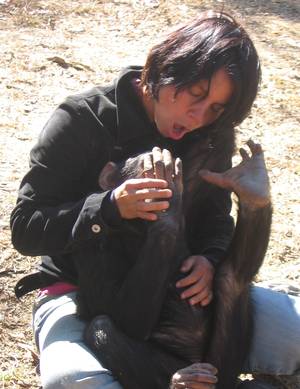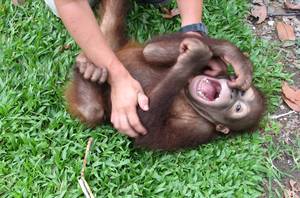Laughter is a wonderful thing to hear - but would you recognise it coming from anything other than a human?
 In a delightful study published in this week's Current Biology, Marina Davila-Ross and colleagues at the University of Plymouth have found that what we think of as laughter today could have evolved in our common ancestor with the apes, between 10 and 16 million years ago.
In a delightful study published in this week's Current Biology, Marina Davila-Ross and colleagues at the University of Plymouth have found that what we think of as laughter today could have evolved in our common ancestor with the apes, between 10 and 16 million years ago.
To test this out, they have been listening to the sounds that were made by 21 young apes when they were tickled, and comparing them to the sounds of a human baby being tickled. These sounds were then subject to an acoustic analysis that could detect similarities and differences between the sounds, and importantly judge how closely related the sounds were.
All in all, they analysed 829 recordings, and looked at 11 different acoustic aspects of these sounds, such as peak frequency, the range of frequencies, the number of calls in a bout etc. They also looked at whether the sounds were made on the inhale, exhale or both.
| Gorilla Laughter | Bonobo Laughter |
| Chimpanzee laughter | Human Laughter |
They found a number of similarities, but also some key differences. It turns out that we humans are much noisier than our ape cousins, as the human babies produced significantly more 'voiced' sounds - these are sounds that clearly come from regular vibration of the vocal cords. The human babies also only laughed on the exhale, while the other apes could laugh both when breathing in and out. They were surprised to see that, while laughing, Chimps and Bonobos could effectively control the rate at which they breathe out - that might not seem surprising, but it was thought t be a uniquely human adaptation that allows us to speak.
 Interestingly, the differences seen for human babies were not one end of a spectrum - these aspects were consistent for the other apes and otherwise, it was actually pretty difficult to tell one species from the next.
Interestingly, the differences seen for human babies were not one end of a spectrum - these aspects were consistent for the other apes and otherwise, it was actually pretty difficult to tell one species from the next.
Next, they put all the data together to create a family tree of laughter and it fit extremely well with a phylogenetic tree, one that shows how closely related species are. Siamang and Orang-utan laughs were more similar to each other than to the other apes, as were Chimps and Bonobos, and humans laugh more like the chimps than the other apes.
It's all too easy to fall into the trap of ascribing human thoughts and intentions to animals - we call it anthropomorphism - but this paper now shows that when an ape is laughing - it's okay to call it a laugh.
But remember don't anthropomorphise animals - they don't like it...










Comments
Add a comment